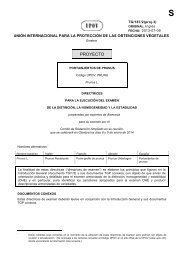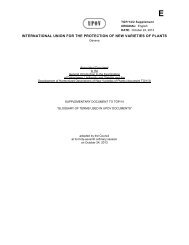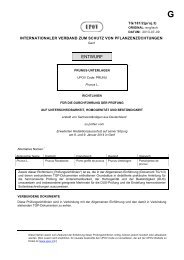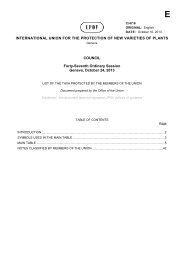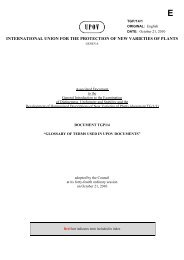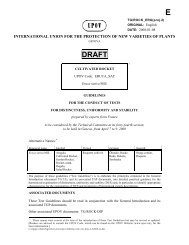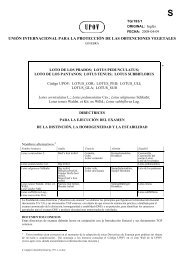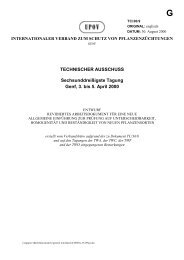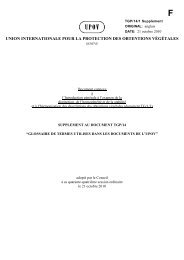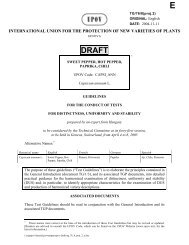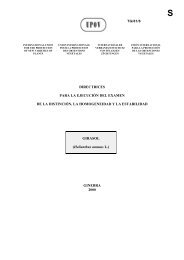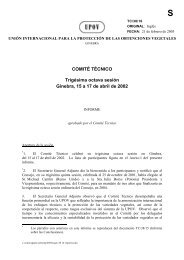TECHNICAL COMMITTEE Forty-First Session Geneva, April 4 to 6 ...
TECHNICAL COMMITTEE Forty-First Session Geneva, April 4 to 6 ...
TECHNICAL COMMITTEE Forty-First Session Geneva, April 4 to 6 ...
Create successful ePaper yourself
Turn your PDF publications into a flip-book with our unique Google optimized e-Paper software.
TC/41/6<br />
page 2<br />
UPOV CODE SYSTEM<br />
2. The TC, at its fortieth session held in <strong>Geneva</strong> from March 29 <strong>to</strong> 31, 2004, agreed <strong>to</strong> the<br />
inclusion of UPOV codes in GENIE on the basis of document TC/40/6-CAJ/49/4.<br />
However, the TC noted that there were certain codes which required checking before their<br />
inclusion and that further consideration of coding of intergeneric and interspecific hybrids and<br />
“multiple ranked names” was required before the completion of GENIE could be achieved.<br />
The developments with regard <strong>to</strong> those and other aspects of the UPOV Code System are<br />
explained below.<br />
Checking of Codes<br />
3. With regard <strong>to</strong> those UPOV codes which still required <strong>to</strong> be checked before inclusion in<br />
GENIE, the TC agreed that these should be checked by the appropriate TWP during their<br />
sessions in 2004. The TWPs agreed that the checking of the codes should be undertaken by<br />
the authorities which had contributed data <strong>to</strong> UPOV concerning the genera and species<br />
concerned. To aid the experts in the checking of these codes, the Office of the Union (the<br />
Office) provided an Excel spreadsheet containing all UPOV codes in which the codes <strong>to</strong> be<br />
checked by each expert were highlighted. The Office also clarified the type of checking<br />
which was required by the experts. The TWPs agreed that the experts should submit their<br />
comments by Oc<strong>to</strong>ber 8, 2004, in order that the checked codes could be incorporated in<br />
GENIE, which was used for the generation of Council documents C/38/5 “Cooperation in<br />
examination” and C/38/6 “List of the taxa protected in the member States of UPOV and in the<br />
States and organizations that have initiated the procedure for acceding <strong>to</strong> UPOV and which<br />
have provided information”.<br />
4. Subsequent <strong>to</strong> the checking of the codes by the TC and TWPs in 2004, there has been a<br />
need <strong>to</strong> introduce some new codes and also <strong>to</strong> amend certain codes (see also paragraph 16).<br />
In accordance with the procedure for the introduction and amendment of codes as agreed by<br />
the TC at its fortieth session, reproduced as Annex I <strong>to</strong> this document, those codes will be<br />
presented <strong>to</strong> the relevant TWP(s), as indicated in Annex II, for their consideration. Annex II<br />
is presented in two parts. Part A is a report on the changes made <strong>to</strong> the UPOV codes and<br />
names in GENIE before an au<strong>to</strong>matic report was introduced in<strong>to</strong> GENIE in February 2005.<br />
Part B is the report of changes made since February 1, 2005, using the au<strong>to</strong>matic report<br />
facility in GENIE; this is the format which will be used for reporting all future<br />
amendments <strong>to</strong> the UPOV codes and names.<br />
Intergeneric and Interspecific Hybrids<br />
5. It was noted by some experts that breeding developments can result in intergeneric<br />
hybrids which could result in “grey areas” between genera.<br />
6. The TC, at its fortieth session, agreed that the UPOV code should reflect the taxonomic<br />
classification. Thus, if a genus exists for a hybrid formed between two genera (e.g. Triticale),<br />
the “genus element” of the UPOV code would be based on the “hybrid” genus. Where a<br />
genus for hybrids did not exist, a code would not be created and varieties bred from two<br />
genera would be classified according <strong>to</strong> the available codes. Where confusion concerning<br />
variety denominations could arise, it would be possible <strong>to</strong> create a new variety denomination<br />
class containing, for example, two genera and hybrids between those genera.



